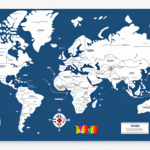Understanding the FedEx Zip Code Zone Chart
If you’re a merchant or frequently ship packages, the FedEx Zip Code Zone Chart is an indispensable tool for estimating shipping costs based on package origin and destination. This guide provides a comprehensive overview of the FedEx Zip Code Zone Chart, offering insights on how to use it effectively to optimize your shipping expenses.
What is the FedEx Zip Code Zone Chart?
The FedEx Zip Code Zone Chart is a system that categorizes shipping locations into different zones, ranging from Zone 2 to Zone 10. These zones determine the shipping rates based on the distance between the origin and destination ZIP codes. The higher the zone number, the greater the distance from the origin, which typically results in higher shipping costs.
FedEx updates the Zip Code Zone Chart annually to reflect changes in ZIP codes and shipping routes. It's crucial to reference the latest chart to ensure accurate shipping rates and delivery estimates. Additionally, the zone designation may vary depending on the type of FedEx service chosen, such as Ground or Express shipping.
How to Use the FedEx Zip Code Zone Chart
Reading the Zone Chart
To determine the shipping zone for your package:
- Locate the origin ZIP code in the leftmost column.
- Find the destination ZIP code in the top row.
- The intersecting cell indicates the zone number for your shipment.
For example, shipping a package from ZIP code 10001 (Zone 4) to ZIP code 90001 would place it in Zone 7.
Calculating Shipping Costs
Once you've identified the zone, you can use the FedEx shipping rate calculator to estimate your shipping costs. Enter your package details, including weight and dimensions, along with the origin and destination ZIP codes, to receive an accurate cost estimate.
Keep in mind that additional factors such as package type, shipping speed, and seasonal demand can influence the final shipping cost.
Factors Influencing FedEx Shipping Rates
Package Weight and Dimensions
The weight and size of your package are primary determinants of shipping costs. Heavier and larger packages generally incur higher shipping fees. FedEx offers a variety of packaging options to help manage these costs, including flat rate boxes for specific services.
Shipping Speed
FedEx provides multiple shipping services with varying delivery speeds, such as:
- FedEx Ground: Cost-effective for less urgent shipments.
- FedEx Express: Faster delivery options for time-sensitive packages.
Choosing a faster shipping option will typically result in higher costs.
Additional Services and Fees
Special handling requirements, like shipping fragile or hazardous items, may incur additional fees. It's essential to properly label your packages to avoid unexpected charges and ensure safe transportation.
Comparing FedEx with Other Shipping Carriers
When planning your shipping strategy, it's beneficial to compare FedEx rates with other carriers such as UPS and USPS. The FedEx Zip Code Zone Chart can be used alongside similar zone charts from other carriers to evaluate the most cost-effective and efficient option for your shipping needs.
Consider factors like delivery speed, reliability, and additional services when making your comparison. For more detailed comparisons, refer to resources like the UPS Shipping Services and the USPS Priority Mail pages.
Tips for Optimizing Shipping Costs
Consolidate Shipments
Reducing the number of shipments by consolidating packages can lead to significant cost savings. Grouping multiple items into a single shipment often lowers the overall shipping expense.
Utilize FedEx Discounts
FedEx offers various discounts for high-volume shippers, military personnel, and businesses with regular shipping needs. Check the FedEx Savings Programs to see if you qualify for any discounts.
Choose the Right Packaging
Using the appropriate packaging can help minimize shipping costs. Consider FedEx’s flat rate boxes for services like FedEx Ground, which offer predictable pricing regardless of package weight (up to a certain limit) and distance.
Plan for Peak Seasons
Shipping rates can fluctuate during peak seasons such as holidays due to increased demand. Planning and scheduling shipments in advance can help avoid higher costs and ensure timely delivery.
Common Mistakes to Avoid
Incorrect ZIP Codes
Entering incorrect origin or destination ZIP codes can lead to inaccurate shipping cost estimates. Double-check all ZIP codes to ensure they are accurate before calculating shipping rates.
Assuming Fixed Rates
Shipping rates are subject to change based on various factors, including fuel prices and seasonal demand. Always refer to the latest FedEx Zip Code Zone Chart and rate calculator for the most current pricing.
Ignoring Additional Fees
Be aware of potential additional fees for special handling, oversized packages, or expedited shipping. Understanding all possible charges can help you avoid unexpected costs.
Benefits of Using the FedEx Zip Code Zone Chart
Utilizing the FedEx Zip Code Zone Chart offers numerous advantages for shipping planning and budgeting:
- Accurate Cost Estimation: Provides a reliable method to estimate shipping expenses based on distance.
- Budget Planning: Helps businesses allocate funds effectively for shipping costs.
- Strategic Shipping Decisions: Enables selection of the most cost-effective shipping options based on destination zones.
- Improved Efficiency: Streamlines the shipping process by providing clear guidelines on rates and zones.
Conclusion
The FedEx Zip Code Zone Chart is a vital tool for anyone involved in shipping packages, offering a structured approach to estimating and managing shipping costs. By understanding how to use the chart effectively and considering the various factors that influence shipping rates, businesses and individuals can optimize their shipping strategies, reduce expenses, and ensure timely deliveries. For the most accurate and up-to-date information, always refer to the official FedEx Shipping Resources.






















